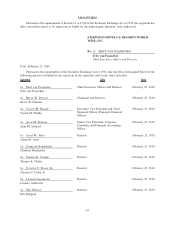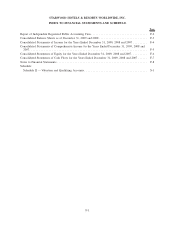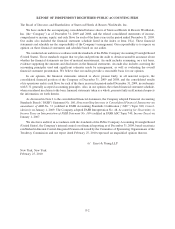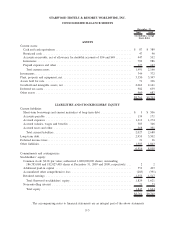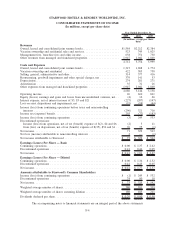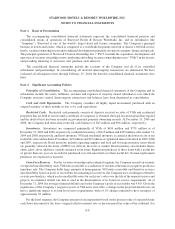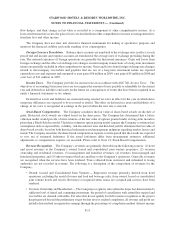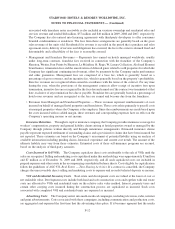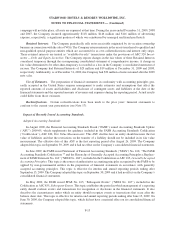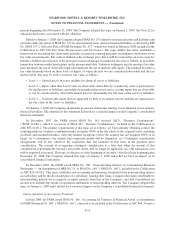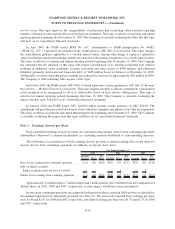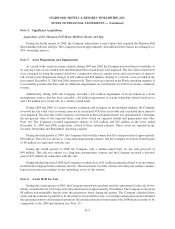Starwood 2009 Annual Report Download - page 132
Download and view the complete annual report
Please find page 132 of the 2009 Starwood annual report below. You can navigate through the pages in the report by either clicking on the pages listed below, or by using the keyword search tool below to find specific information within the annual report.impaired loans, the Company establishes a specific impairment reserve for the difference between the recorded
investment in the loan and the present value of the expected future cash flows or the estimated fair value of the
collateral. The Company applies the loan impairment policy individually to all loans in the portfolio and does not
aggregate loans for the purpose of applying such policy. For loans that the Company has determined to be impaired,
the Company recognizes interest income on a cash basis.
Assets Held for Sale. The Company considers properties to be assets held for sale when management
approves and commits to a formal plan to actively market a property or group of properties for sale and a signed
sales contract and significant non-refundable deposit or contract break-up fee exist. Upon designation as an asset
held for sale, the Company records the carrying value of each property or group of properties at the lower of its
carrying value which includes allocable segment goodwill or its estimated fair value, less estimated costs to sell, and
the Company stops recording depreciation expense. Any gain realized in connection with the sale of a property for
which the Company has significant continuing involvement (such as through a long-term management agreement)
is deferred and recognized over the initial term of the related agreement (See Note 12). The operations of the
properties held for sale prior to the sale date, if material, are recorded in discontinued operations unless the
Company will have continuing involvement (such as through a management or franchise agreement) after the sale.
Investments. Investments in joint ventures are generally accounted for under the equity method of account-
ing when the Company has a 20% to 50% ownership interest or exercises significant influence over the venture. If
the Company’s interest exceeds 50% or, if the Company has the power to direct the economic activities of the entity
and the obligation to absorb losses, the results of the joint venture are consolidated herein. All other investments are
generally accounted for under the cost method.
The fair market value of investments is based on the market prices for the last day of the period if the
investment trades on quoted exchanges. For non-traded investments, fair value is estimated based on the underlying
value of the investment, which is dependent on the performance of the investment as well as the volatility inherent in
external markets for these types of investments. In assessing potential impairment for these investments, the
Company will consider these factors as well as forecasted financial performance of its investment. If these forecasts
are not met, the Company may have to record impairment charges.
Plant, Property and Equipment. Plant, property and equipment, including capitalized interest of $4 million,
$10 million and $10 million incurred in 2009, 2008 and 2007, respectively, applicable to major project expenditures
are recorded at cost. The cost of improvements that extend the life of plant, property and equipment are capitalized.
These capitalized costs may include structural improvements, equipment and fixtures. Costs for normal repairs and
maintenance are expensed as incurred. Depreciation is recorded on a straight-line basis over the estimated useful
economic lives of 15 to 40 years for buildings and improvements; 3 to 10 years for furniture, fixtures and
equipment; 3 to 20 years for information technology software and equipment and the lesser of the lease term or the
economic useful life for leasehold improvements. Gains or losses on the sale or retirement of assets are included in
income when the assets are sold provided there is reasonable assurance of the collectibility of the sales price and any
future activities to be performed by the Company relating to the assets sold are insignificant.
The Company evaluates the carrying value of its assets for impairment. For assets in use when the trigger
events specified in Accounting Standards Codification (“ASC”) 360, Property Plant, and Equipment occur, the
expected undiscounted future cash flows of the assets are compared to the net book value of the assets. If the
expected undiscounted future cash flows are less than the net book value of the assets, the excess of the net book
value over the estimated fair value is charged to current earnings. Fair value is based upon discounted cash flows of
the assets at rates deemed reasonable for the type of asset and prevailing market conditions, comparative sales for
similar assets, appraisals and, if appropriate, current estimated net sales proceeds from pending offers.
Goodwill and Intangible Assets. Goodwill and intangible assets arise in connection with acquisitions,
including the acquisition of management contracts. The Company does not amortize goodwill and intangible assets
with indefinite lives. Intangible assets with finite lives are amortized on a straight-line basis over their respective
F-9
STARWOOD HOTELS & RESORTS WORLDWIDE, INC.
NOTES TO FINANCIAL STATEMENTS — (Continued)


